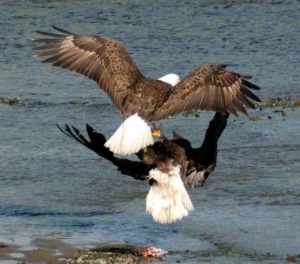What happens when a bald eagle is hurt in Tampa Bay — but no one is there to help it?
 Hopefully, someone knows to call Nancy Murrah, a certified wildlife rehabilitator, and she picks it up. If there’s room, she drives it to Maitland where Florida Audubon operates the closest rehabilitation center with cages suitable for bald eagles.
Hopefully, someone knows to call Nancy Murrah, a certified wildlife rehabilitator, and she picks it up. If there’s room, she drives it to Maitland where Florida Audubon operates the closest rehabilitation center with cages suitable for bald eagles.
As vice president of Tampa Bay Raptor Rescue, Murrah is spearheading a fundraising effort to build the first rehabilitation facility in the region with cages large enough for raptors like eagles and ospreys to be reconditioned for flight before they are released back into the wild. As planned, and over time, the facility also will include an education center for visitors who can watch the process of rehabilitating and releasing birds.
“There’s nothing like that anywhere in the Southeast,” said Murrah.
 “It’s a very exciting concept,” adds Ross Dickerson, Hillsborough County’s environmental land manager. “There’s definitely a need for it in the region and it would help put Hillsborough County on the map for birders. It also will work as an introduction to other people who don’t know why these birds need our protection.”
“It’s a very exciting concept,” adds Ross Dickerson, Hillsborough County’s environmental land manager. “There’s definitely a need for it in the region and it would help put Hillsborough County on the map for birders. It also will work as an introduction to other people who don’t know why these birds need our protection.”
Long respected in the birding community, Murrah is Audubon’s Hillsborough County EagleWatch Coordinator as well as its second vice president. She also holds permits from the Florida Fish and Wildlife Conservation Commission as a transporter, facilitator for Project Wild, Flying Wild and Aquatic Wild, Colony Watch and Jay Watch.
Murrah is working with landowners like Mosaic as well as Hillsborough County to find an appropriate site that had been purchased through the Jan K. Platt Environmental Lands Acquisition and Protection Program (ELAPP).
The total budget, excluding land, is about $5 million but Murrah expects to start out small and build the facility over time. “We could start with a couple of portable classrooms or portable shipping containers if we had the land, electricity, water and a septic system,” she notes.
T he need for both rehabilitation facilities and education programming is dramatic, Murrah said. “Just last week, two female eagles had a fight and one was severely wounded. No one knew who to call so she spent the night on the ground in the cold rain. Hopefully the other bird was not as wounded and could safely fly away — but we may never know.”
he need for both rehabilitation facilities and education programming is dramatic, Murrah said. “Just last week, two female eagles had a fight and one was severely wounded. No one knew who to call so she spent the night on the ground in the cold rain. Hopefully the other bird was not as wounded and could safely fly away — but we may never know.”
As soon as Murrah heard about the grounded bird, she picked her up and transported her to the medical facilities in Maitland where she is recovering. “She doing well but other birds would have a much better chance for survival if medical care was available more quickly.”
Fighting birds, along with fledglings who fall from cell towers because nesting space in their preferred pine trees has become rare, are likely to become a much bigger issue in the future, she adds. “These are very territorial birds and they will fight to the death to protect their territories which are shrinking as the population grows.” (Learn more about how you can help protect bald eagles here.)
Along with bald eagles – her personal favorite – the new facility will have flight cages for all 12 raptor species found in Tampa Bay as well as two additional cages for occasional visitors like golden eagles or peregrine falcons. “We’ll need at least 8.5 acres to accommodate the facility we’re planning,” she said.
The size of the cages will range from 20 feet to more than 100 feet long and at least 20 feet high, depending on the species. “We hope to get corporate sponsors for the cages, once we get far enough along to know when and where they’ll be built,” she adds. Each cage will cost $40,000 to $200,000.
The eagle flight cage will be built with an octagonal footprint based on plans created by an avian veterinarian in Nova Scotia that allows eagles to recondition themselves by flying in circles.
Location to be determined
While ELAPP has purchased more than 61,000 acres of land, most are set aside as preserve areas where extensive development would not be allowed, Dickerson said. “But sometimes we end up with what we call ‘acquisitions of convenience’ because they are a piece of property the owner wants to sell. They’re not part of the preserve, which would not allow such intensive use.”
That’s resulted in two of the county’s most popular attractions: the BMX trail and radio-controlled airplane facilities outside Triple Creek Preserve. “Hopefully people will come out to use these facilities and then walk through the preserve next door and learn to really enjoy nature.”
Murrah hopes the same thing happens with people who visit the new raptor rescue. “People need to realize that these birds need us to survive in habitats we’ve left for them.”
Learn more at http://www.tampabayraptorrescue.org/ including hotline information to report injured birds.
